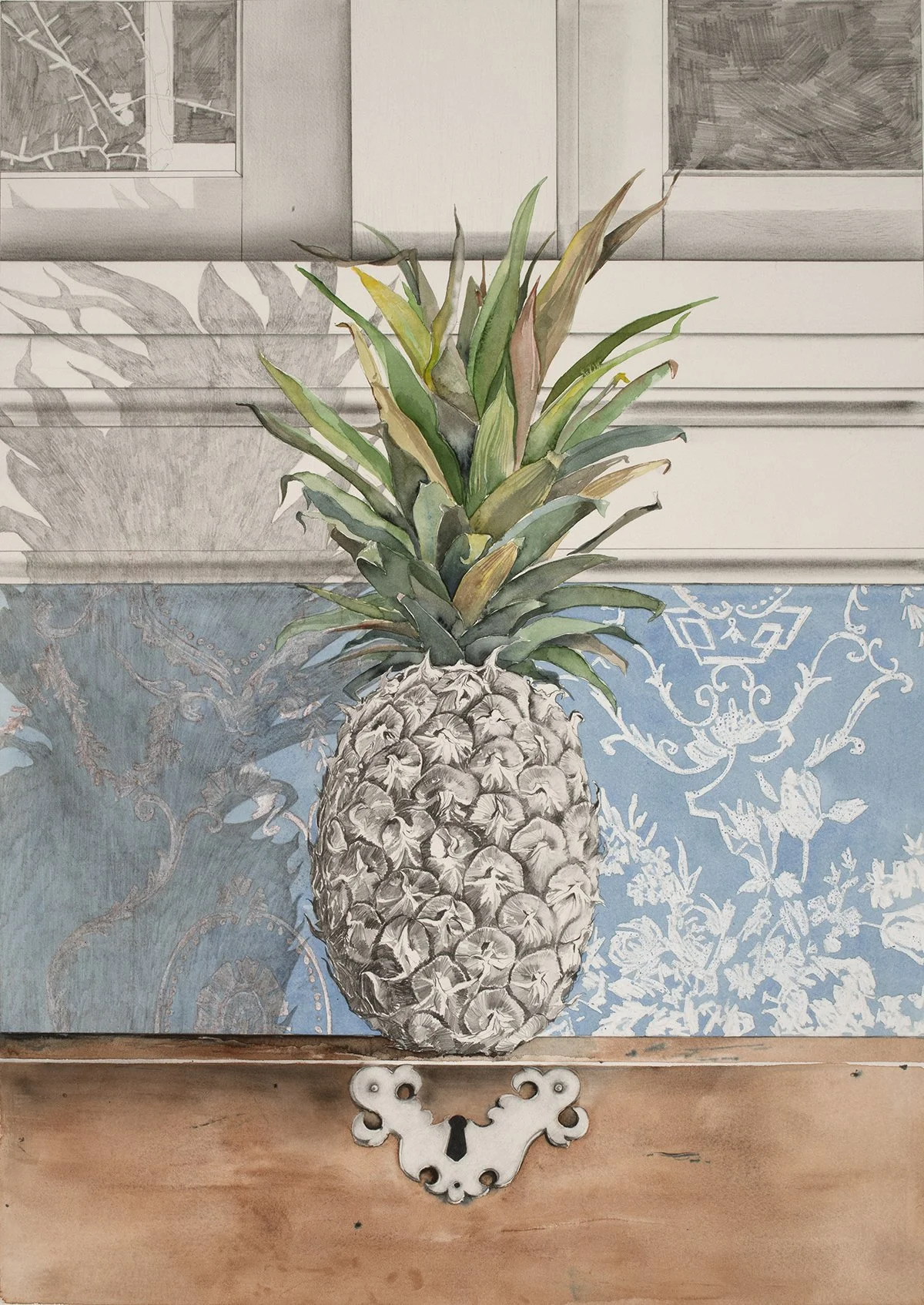BETWEEN ABSTRACTION AND REPRESENTATION
Essay by J. Susan Isaacs, PhD
Transition to Watercolor In 1980, the couple moved to Wilmington, Delaware for Denison’s new job. Although Wendy brought her printing press and studio supplies to her new home, she never reconstituted her printmaking studio. There were several reasons for this change. First, they moved into a 1926 vintage semi- detached home that while lovely, needed attention. A hard worker imbued with a New Englander’s independent spirit, Wendy undertook the renovations herself, stripping wallpaper and painting both the interior and exterior of the house. She also began to teach drawing and painting at Widener University in Chester, Pennsylvania, and watercolor painting at the Delaware Art Museum in Wilmington.1
Watercolor was a relatively new medium for Hatch, but one that appealed to her for reasons other than the process itself. She wanted to start a family and was aware of the health hazards associated with many of the materials employed at that time in the printmaking process.2 Determined to improve her skills, she researched the various watercolor techniques and began experimenting. Hatch became as accomplished in watercolor as she had been in printmaking, expanding her craft to large sheets of cold-pressed paper.
Two of her untitled pencil and watercolor paintings from 1981 demonstrate an American taste for linearity that goes back to the colonial era. Each features details from Hatch’s home, a pineapple and a crystal wall sconce. The first is a traditional symbol of hospitality; the latter, a traditional decorative object found in a historic home. Denison’s father collected American Folk painting, such as the work of New England artist William Matthew Prior.3 Wendy’s paintings demonstrate the sophistication of art school training, but they also show her continued exploration of decorative patterns and a taste for precise drafting that harkens back to the linearity of American limners and folk artists. These paintings, too, illustrate her continued concern for pattern and design.
Between 1975 and 1985, the Pattern and Decoration movement developed on the West Coast.4 Like the artists of this movement, Hatch shared an interest in such things as wallpaper patterns and ornamental textiles. The Women’s Movement also emphasized traditionally feminine subjects and materials. Hatch’s comfort with watercolor, a medium that had largely been associated with women, and considered less important than oil, and her employment of the domestic objects found in her own home as subjects, can be seen as part of this new anti-Minimalist attitude.
Though Hatch’s work was reflective of the zeitgeist, she did so independently. She created work without worrying about its connection to urban arts centers. This is not to say that she was unaware of contemporary art and artists, she was and remains so, but like so many women outside of the mainstream artworld she listened to her own voice.5 Hatch’s studio was in her home, and she depicted the objects found throughout her household. Still lifes, ranging from dishes to food to plants and more, became her dominant subject matter. This domestic content continued to provide creative material for numerous years.
Many of Hatch’s paintings present an aerial view of her subject. She became fascinated with metallic surfaces as well as patterned fabrics, laces, and the layering of complex compositions. She pursued difficult to depict surfaces like glass, and over time, she increased her paper size as well. Throughout the 1980s and 90s, Hatch portrayed complex still life setups with objects of varying surface textures.
Untitled (pineapple)
1981
Watercolor and pencil on arches paper
27 × 19 inches
Untitled (amaryllis)
1985
Watercolor on arches paper
29 × 41 inches
Pillow
1999
Watercolor on arches paper
29 × 41 inches
Collection of President Joseph R. Biden and First Lady Jill Biden
NOTES
1. While not all museums have a strong studio program, the DAM developed art classes early in its history. Founded as The Delaware
Art Center in 1938, five years later it joined with the Wilmington Academy of Art to establish the Center’s first educational programs.
By 1954, nearly 500 students per year were enrolled in studio art classes, and new studios and classrooms
were constructed in 1956.
It became the Delaware Art Museum in 1972 “Museum History,” https://delart.org/ visit/museum-history/ Accessed August 7, 2021.
2. Today, more and more artists are changing to non-toxic printmaking and developing environmentally sound processes, but this was not prevalent in the early 1980s. Happily, Denison III was born in 1984 and Erica in 1987.
3. “Artist and Visionary: William Matthew Prior Revealed,” The American Folk Art Museum, https:// folkartmuseum.org/ exhibitions/artist-and- visionary-william-matthew- prior-revealed/ Accessed August 8, 2021.
4. Elissa Auther, Anna Katz et al, With Pleasure: Pattern and Decoration in American Art 1972-1985, New Haven: The Museum of Contemporary Art, Los Angeles in Association with Yale University Press, 2020.
5. Both Denison and Wendy have been involved with the Delaware Center for the Contemporary Arts, now the Delaware Contemporary, for many years. The Elizabeth Denison Hatch Gallery, established in 2001, is in honor of Denison’s sister who died in a motorcycle accident shortly before the DCCA moved to its current building in 2001. They have traveled extensively and regularly visit museums and galleries.


